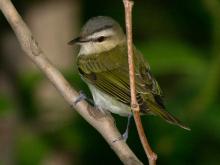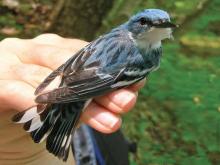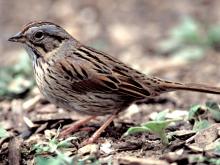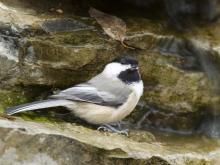Birds
Media

Species Types
Scientific Name
Vireo olivaceus
Description
Singing an incessant series of question-and-answer homilies from dawn to dusk, even through the hottest of summer days, the red-eyed vireo has been called the “preacher bird.”
Media

Species Types
Scientific Name
Setophaga dominica (formerly Dendroica dominica)
Description
The yellow-throated warbler creeps along branches high in the tops of trees, searching the bark for insects. Listen for its distinctive song, a cascade of clearly whistled tew notes.
Media

Species Types
Scientific Name
Setophaga cerulea (formerly Dendroica cerulea)
Description
A summer resident in Missouri, the cerulean warbler is more common in the southeastern Ozarks but rare elsewhere in the state. Its numbers are small and declining, and for that reason our nation may soon classify it as endangered.
Media

Species Types
Scientific Name
Dolichonyx oryzivorus
Description
The male bobolink is the only North American bird that has light feathers above and dark feathers below. In fall and winter, the male resembles the buffy and brown-streaked female.
Media

Species Types
Scientific Name
Melospiza lincolnii
Description
Lincoln's sparrow is small and shy, with fine streaks on its breast. In late fall and early spring, look for them along prairie edges and at bird feeders.
Media

Species Types
Scientific Name
Sitta carolinensis
Description
White-breasted nuthatches, the upside-down birds, creep up and down tree trunks and on the tops and bottoms of branches. The call is a nasal “yank” or “yank-yank.”
Media

Species Types
Scientific Name
Poecile atricapillus and P. carolinensis
Description
Chickadees are common in backyards. These black-capped, perky insectivores are present year-round. There are two species in Missouri that look quite similar.
Media

Species Types
Scientific Name
Sayornis phoebe
Description
Eastern phoebes often build their mud-and-plant nests on the side of a house, just under a roof or other overhang. These small flycatchers repeatedly cry out their own name: “FEE-bee! FEE-bee!”
See Also







Media

Species Types
Scientific Name
Hemaris diffinis
Description
The snowberry clearwing is a moth that confuses people because it looks like a bumblebee and flies like a hummingbird!
Media

Species Types
Scientific Name
Hyles lineata
Description
The white-lined sphinx moth sometimes confuses people because it flies, hovers, and eats from flowers like a hummingbird. The adults often fly during daylight hours as well as in the night and are often found at lights.
Media

Species Types
Scientific Name
Darapsa myron
Description
The Virginia creeper sphinx moth is common in woods and brushy areas and comes to lights at night. The larvae eat Virginia creeper and grape leaves.
Media

Species Types
Scientific Name
Perimyotis subflavus (formerly Pipistrellus subflavus)
Description
Tri-colored bats, formerly called eastern pipistrelles, are relatively small and look pale yellowish or pale reddish brown. The main hairs are dark gray at the base, broadly banded with yellowish brown, and tipped with dark brown.
Media

Species Types
Scientific Name
Myotis grisescens
Description
Gray myotises are difficult to distinguish from other mouse-eared bats. A key identifying feature of the gray myotis is that its wing is attached to the ankle and not at the base of the toes. It’s an endangered species.
Media

Species Types
Scientific Name
Myotis lucifugus
Description
The little brown myotis (little brown bat) is one of our most common bats, but populations are declining. White-nose syndrome has taken a heavy toll in northeastern states. This species is now listed as vulnerable across its range.
Media

Species Types
Scientific Name
Myotis sodalis
Description
The Indiana myotis, or Indiana bat, summers along streams and rivers in north Missouri, raising its young under the bark of certain trees. It is an endangered species.
About Birds in Missouri
About 350 species of birds are likely to be seen in Missouri, though nearly 400 have been recorded within our borders. Most people know a bird when they see one — it has feathers, wings, and a bill. Birds are warm-blooded, and most species can fly. Many migrate hundreds or thousands of miles. Birds lay hard-shelled eggs (often in a nest), and the parents care for the young. Many communicate with songs and calls.





















